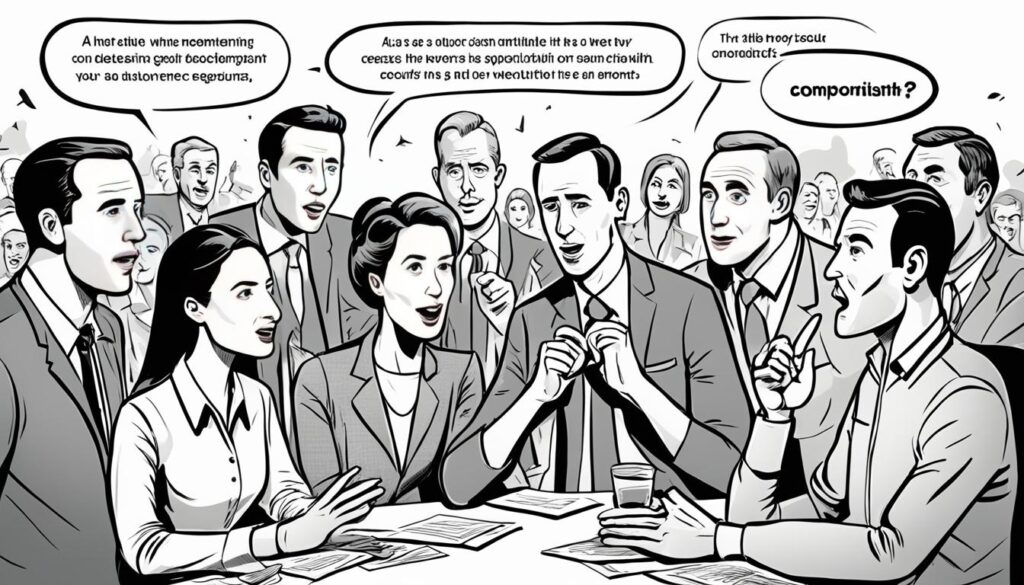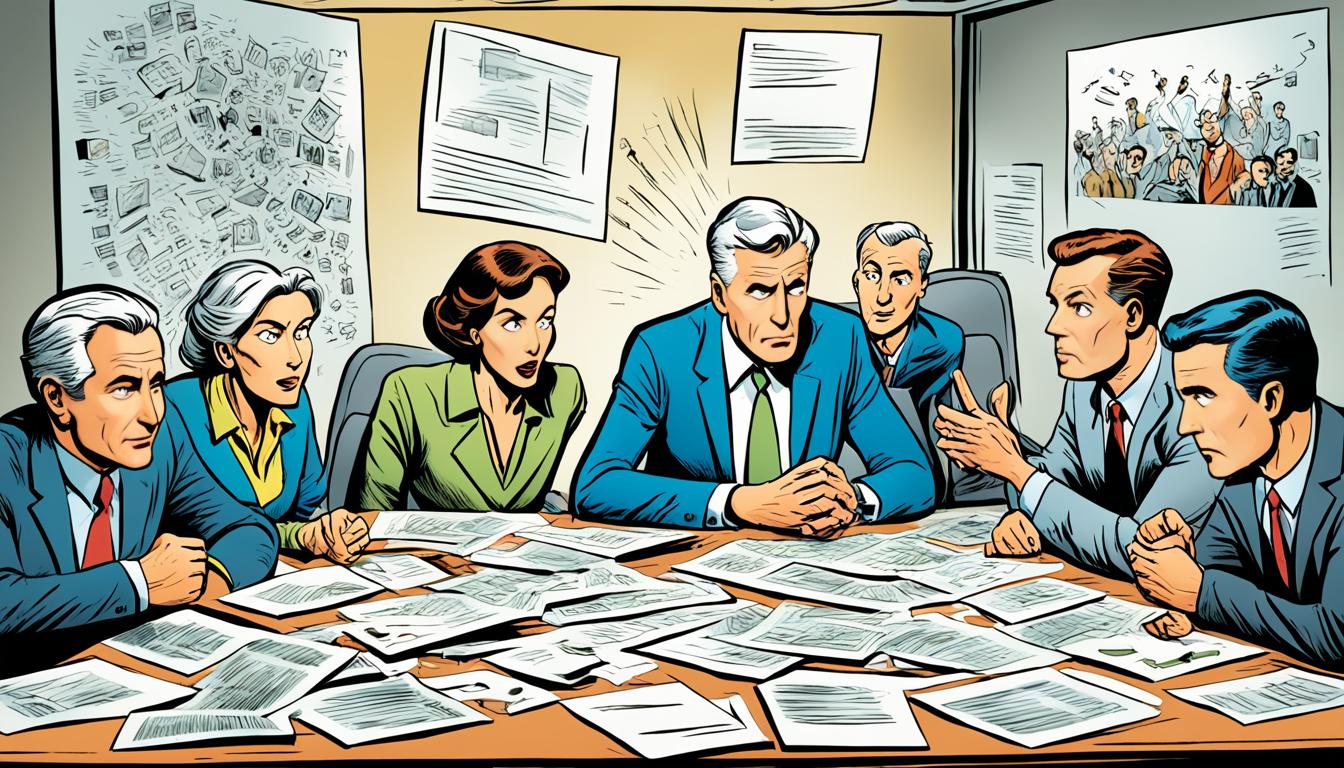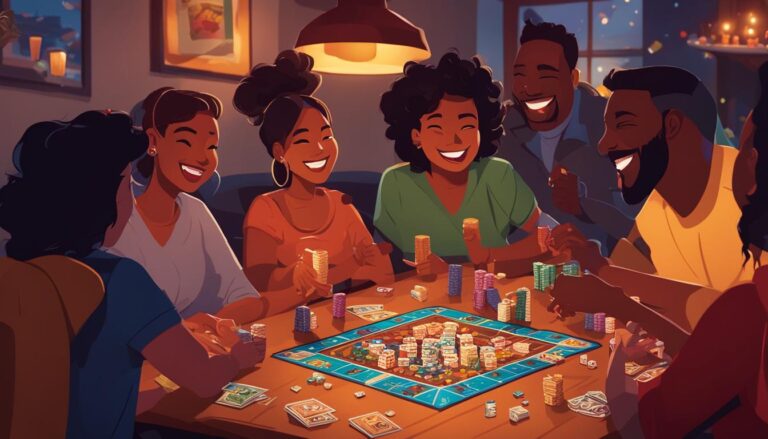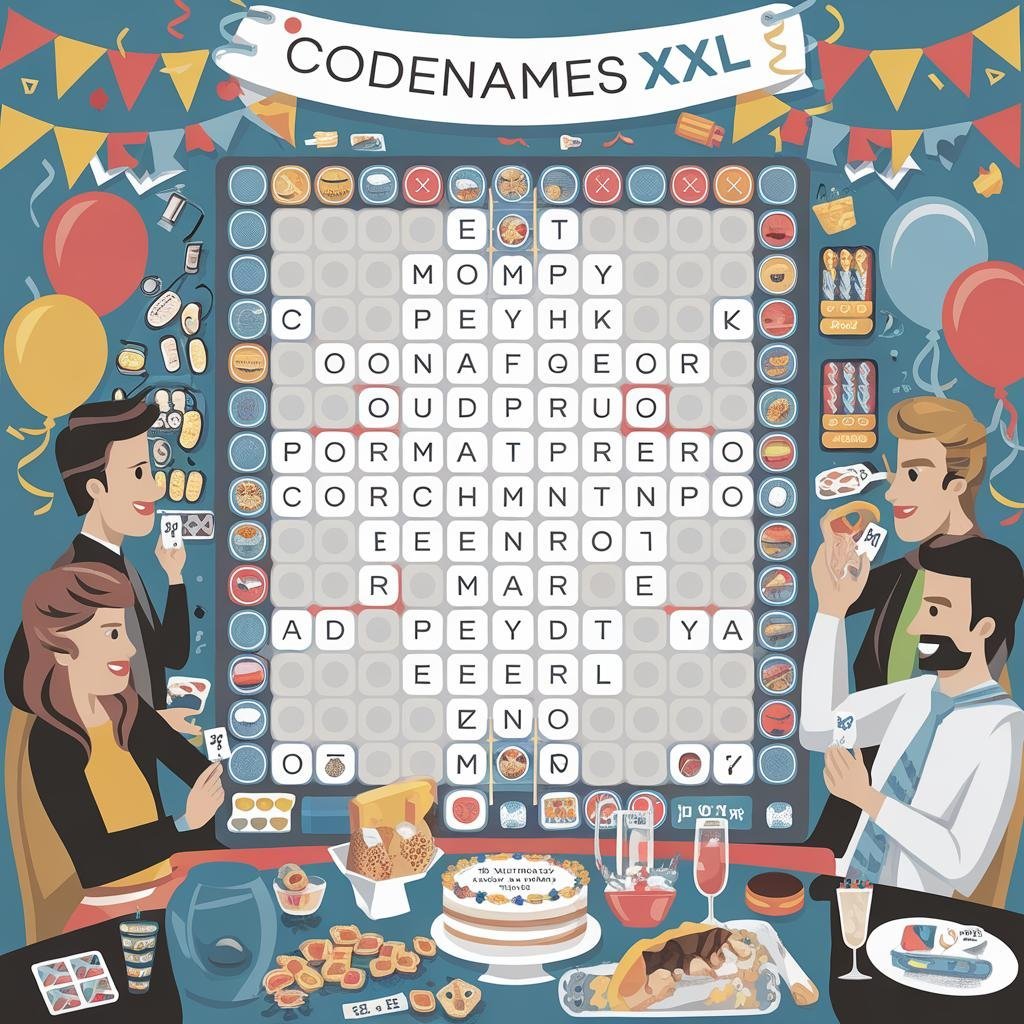Disclosure: This Post Contains Affiliate Links; We earn a commission on purchases.
Welcome to a world of intrigue and rebellion, where plotting against oppression and organizing resistance movements are the keys to overthrowing tyranny. Step into the world of The Resistance, a thrilling party game that pushes players to their limits as they navigate secret identities, social deduction, and deception. Are you ready to join the resistance and plot the downfall of dictators?
Key Takeaways:
- Plan rebellions and organize protests in The Resistance, a captivating party game.
- Engage in underground plotting to overthrow tyrannical leaders and fight for freedom.
- Experience the thrill of social deduction, secret identities, and strategic gameplay.
- Enhance your gaming experience with high-quality components and visually appealing artwork.
- Unlock the game’s replay value and explore expansions and variations for endless entertainment.
Table of Contents
The Concept of The Resistance
The Resistance is a social role-playing card-based game that immerses players in the thrilling world of resistance movements and secret plotting against oppression. Set in a fictional war-torn society, the game simulates the ongoing conflict between the government and resistance groups. Each player is assigned a specific role within these factions, with some becoming brave resistance members and others cunning spies.
The goal of the resistance members is to successfully carry out missions that undermine the oppressive regime and ultimately lead to its downfall. These missions require careful planning, coordination, and execution. On the other hand, the spies aim to obstruct the resistance’s progress by sabotaging the missions. They strategically work to sow doubt and confusion among the resistance members, making it harder for them to achieve their objectives.
The concept of The Resistance revolves around the notion of resistance movements uniting and organizing to fight against oppression. It explores the strategies, sacrifices, and risks involved in plotting the downfall of dictators and oppressive regimes. The game challenges players to navigate a world of secrecy, deception, and betrayal as they work together to plan rebellions and dismantle the existing order.
“In The Resistance, players step into the shoes of brave resistance members and cunning spies, engaging in a battle of wits, strategy, and secrecy. Can you outsmart your foes and lead the resistance to victory, or will the spies in your midst bring about your downfall? The fate of the nation is in your hands.” – BoardGameGeek
How to Play The Resistance
The Resistance is an exciting and strategic party game that puts players in the midst of resistance movements and secret plotting. In this section, we will guide you through the gameplay mechanics of The Resistance, from assigning roles to carrying out missions.
The game begins by assigning secret roles to each player, creating an atmosphere of mystery and intrigue. Some players will be designated as resistance members, while others will take on the role of spies. The resistance members aim to carry out missions successfully, while the spies work covertly to undermine these missions.
At the start of the game, a leader is randomly chosen. The leader’s responsibility is to select a team of players to go on a mission. The team composition is crucial, as it determines the likelihood of success or failure. The leader must consider each player’s trustworthiness and abilities before making their decision.
Once the leader has chosen the mission team, all players participate in a voting phase. Every player has a voice in determining whether the proposed team should proceed on the mission. This creates an opportunity for strategic discussions, negotiations, and alliances within the group.
If the team is approved by the majority, the mission is carried out. Each team member submits a mission card indicating success or failure. The mission’s outcome depends on the collective cards played. If even one failure card is played, the mission fails.
The game continues with new leaders and missions until one side achieves its objective. Resistance members aim to complete a set number of successful missions, while spies strive to sabotage these missions to prevent the resistance from succeeding.
The dynamic gameplay of The Resistance keeps players engaged and on their toes. By carefully planning rebellions, organizing protests, and engaging in underground plotting, you can lead your team to victory or strategically dismantle their plans.
Components of The Resistance
The Resistance comes with high-quality components that enhance the gameplay experience. The game includes:
- Thick cards with a linen finish for character cards and mission cards.
- A board to track the progress of the game.
- Tokens for various game mechanics.
- Additional game-modifying plot cards.
The character cards represent the different roles within the resistance and spy groups, allowing players to immerse themselves in the game’s theme. The plot cards add special effects to the game when played by the Mission Leader, adding an extra layer of strategy and intrigue.
The Theme and Artwork of The Resistance
The theme of The Resistance centers around resistance movements plotting against oppression and overthrowing tyrannical leaders. The game delves into the serious and intense nature of resistance movements, capturing the determination and courage of those fighting against tyranny. Through its gameplay mechanics and narrative, The Resistance immerses players in a world where freedom fighters must strategize, plan, and work together to bring about meaningful change.
The artwork in The Resistance may not be visually stunning, but it effectively supports the game’s theme and enhances the overall atmosphere. The illustrations depict characters and scenes related to the resistance and spy groups, showcasing the resolve and bravery of those involved in plotting against oppression. The artwork serves as a visual reminder of the stakes involved, creating a sense of urgency and intensity throughout the game.
While the artwork may not be the highlight of The Resistance, it provides a cohesive visual representation of the resistance movements and the struggles they face. The illustrations add depth and immersion to the game, allowing players to fully immerse themselves in the narrative and feel the weight of their mission to overthrow tyranny.
The Gameplay and Mechanics of The Resistance
The gameplay of The Resistance is centered around social deduction, secret identities, bluffing, and deception. Players must carefully analyze the actions and behaviors of their fellow players to determine who may be spies and who they can trust. This aspect of the game adds a thrilling element of uncertainty and keeps players on their toes throughout each playthrough.
The game is divided into two main phases: the voting phase and the mission phase. In the voting phase, players participate in a democratic process to determine the composition of the mission teams. Through discussion, debate, and careful observation, players attempt to sway the votes in their favor and put forward a team that they believe will successfully complete the mission.
Once a mission team is approved, the game proceeds to the mission phase. Each player on the mission team receives a mission card and secretly selects whether to play a success or a failure card. Success cards contribute to the mission’s success, while failure cards sabotage the mission. It is during this phase that players must decide whether to trust their teammates or suspect them of being spies.
The result of each mission determines the overall progress of the game. If any failure cards are played, the mission fails, pushing the resistance one step closer to defeat. However, if all mission cards are successes, the resistance gains ground in their fight against the oppressive regime.
The strategic decision-making, deductive reasoning, and mind games involved in The Resistance create a tense and suspenseful experience that keeps players engaged and constantly second-guessing each other’s motives.
The gameplay mechanics of The Resistance make it a dynamic and interactive game that requires careful analysis, persuasive communication, and the ability to deceive and detect deception. It is through these mechanics that players experience the excitement and intensity of working towards their goals while constantly navigating the treacherous world of secret identities and hidden agendas.
| Gameplay Elements | Description |
|---|---|
| Social Deduction | Players must analyze the actions and behaviors of others to determine who may be spies and who to trust. |
| Secret Identities | Each player has a secret role as either a resistance member or a spy, adding an element of mystery and hidden agendas. |
| Bluffing | Players use their acting skills and strategic thinking to bluff and deceive their opponents. |
| Deception | Spies aim to deceive the resistance members by sabotaging missions while appearing innocent. |
| Voting Phase | Players discuss, debate, and vote on the composition of mission teams. |
| Mission Phase | Players on the mission team secretly play mission cards to determine the success or failure of the mission. |
The Replay Value of The Resistance
The replay value of The Resistance is one of its key strengths, offering players endless opportunities for engaging gameplay and strategic exploration.
The interactive nature of the game ensures that each playthrough is unique, with different dynamics and outcomes based on the decisions and actions of the players involved. The game heavily relies on the interaction between players, creating a dynamic environment where observations, analysis, and social deduction are essential.
With each playthrough, players have the opportunity to develop new strategies and tactics, refining their approaches based on lessons learned from previous games. This ever-evolving gameplay keeps the experience fresh, exciting, and challenging, ensuring that players are always engaged.
In addition, the inclusion of plot cards further enhances the replay value of The Resistance. These cards, introduced in the expansion “The Plot Thickens,” add depth and variety to the gameplay by introducing additional abilities and options for the Mission Leader. Plot cards can dramatically alter the course of a game, keeping players on their toes and introducing new strategic considerations.
The replay value of The Resistance lies not only in the mechanics of the game but also in the social aspect of playing with different groups of people. Each group brings its unique dynamics, communication styles, and gameplay approaches, adding an extra layer of variation to the experience. Whether playing with close friends, family, or new acquaintances, the interactive nature and replay value of The Resistance ensure that every game is a memorable and enjoyable experience.

| Key Factors | Benefits |
|---|---|
| Interactive gameplay | Engaging and dynamic experience |
| Player interaction | Creates unique dynamics and strategic considerations |
| Development of new strategies | Keeps the game fresh and exciting |
| Inclusion of plot cards | Enhances gameplay depth and variety |
| Playing with different groups | Brings unique dynamics and variation to the experience |
The Strategies and Tactics in The Resistance
In The Resistance, success hinges on the strategic planning and tactical execution of resistance members. The game poses a thrilling challenge as players must navigate a treacherous landscape of secret identities and covert operations. To achieve their objective of overthrowing tyranny and plotting against oppression, resistance members employ various strategies to outwit the spies in their midst.
The resistance plot strategies in The Resistance involve collaboration, information sharing, and careful analysis of voting patterns. By working together, resistance members can piece together clues and identify potential spies. Open communication and trust-building exercises are crucial for establishing a united front against the oppressors.
“By pooling our knowledge and observing the actions of others, we can uncover the spies and expose their treachery.” – Resistance Leader
Meanwhile, the spies must employ different tactics to blend in and sabotage missions without raising suspicion. Subtle and calculated, their moves must be covertly executed. By exploiting divisions within the resistance and manipulating trust, the spies sow discord among their adversaries.
To successfully navigate this game of deception and deduction, communication, observation, and deductive reasoning are vital skills for both resistance members and spies. Being able to read between the lines, identify inconsistencies, and analyze player behaviors can be the key to victory.
Strategies for Resistance Members:
- Share information: By openly discussing mission outcomes and suspicions, resistance members can uncover valuable insights and form alliances.
- Analyze voting patterns: Paying close attention to how players vote on mission teams can reveal valuable clues about their allegiance.
- Observe player behaviors: Detecting inconsistencies in actions, statements, or voting can help identify potential spies.
- Coordinate actions: Planning collaborative efforts and synchronizing mission outcomes can increase the resistance’s chances of success.
Tactics for Spies:
- Blend in: Act as a trusted member of the resistance by carefully mimicking their behaviors and voting patterns.
- Fuel suspicion: Sow doubt and discord among the resistance members by subtly casting doubt on their choices or spreading misinformation.
- Sabotage strategically: Choose mission cards that will ensure failures while avoiding detection.
- Manipulate trust: Identify key resistance members and exploit their vulnerabilities to create division and mistrust.
The Strategies and Tactics in The Resistance require both sides to be cunning, observant, and adaptive. The resistance members must rally their forces and gather evidence to expose the spies within, while the spies must operate covertly and undermine the resistance’s efforts. Only through careful planning, skilled execution, and strategic maneuvering can the resistance plot strategies succeed in overthrowing tyranny and plotting against oppression.
The Role of Table Talk in The Resistance
Table talk, or the ability to openly discuss the game and share information, plays a crucial role in The Resistance. It is a communication and collaboration tool that allows players to strategize, debate, and persuade others of their loyalty or deceive them as spies. By engaging in lively discussions and negotiations, players can form alliances, gather valuable information, and build trust within the group.
During gameplay, table talk fosters collaboration and encourages players to work together towards a common goal. It enables the resistance members to coordinate their efforts, plan missions, and uncover the spies among them. Effective communication is key to devising successful strategies and ensuring the smooth execution of missions.
“We must not underestimate the power of table talk. Through open dialogue and sharing of information, we can strengthen our resistance movement and outwit the spies. Trust is built through our words, and our unity will lead us to victory.” – Resistance Agent
On the other hand, spies can also manipulate the table talk to their advantage. They can sow doubt among the resistance members, spread misinformation, and divert attention from their true identities. By carefully choosing their words and playing mind games, spies can deceive others and sabotage the mission’s success.
It is important to note that each group may have a different approach to table talk. While some groups may prefer lively and vocal discussions, others may opt for a more silent and observant strategy. By closely observing the conversations and analyzing non-verbal cues, players can glean valuable information and make informed decisions.
Benefits of Table Talk:
- Facilitates collaboration and teamwork
- Encourages strategizing and planning
- Promotes social interaction and engagement
- Allows for negotiation and persuasion
- Enhances the immersive experience of the game
Tips for Effective Table Talk:
- Be diplomatic and persuasive in your discussions
- Listen attentively to others and analyze their statements
- Use logic and deductive reasoning to form alliances and identify spies
- Stay aware of non-verbal cues and body language
- Adapt your approach based on the group dynamic and preferences
In summary, table talk plays a vital role in The Resistance by enabling communication, collaboration, and strategic decision-making. Whether engaging in lively debates or maintaining a watchful silence, players can leverage the power of table talk to navigate the intricate web of loyalty, deception, and intrigue in their quest for victory.

The Influence of Player Count on The Resistance
The player count in The Resistance significantly impacts the gameplay and group dynamics. With more players, there are more potential spies, making it harder for the resistance members to identify them. Larger groups also require more coordination and strategic planning to successfully carry out missions. On the other hand, smaller groups offer a more intimate and intense experience, with fewer players to deceive and greater individual influence on the game. The optimal player count depends on the group’s preferences and desired level of complexity.
Playing The Resistance with a larger group of players adds complexity and challenges to the gameplay. With more players involved, there is a higher chance of having spies in the resistance team. This makes it more difficult for resistance members to trust each other and successfully complete missions. The increased number of potential spies also adds variability to the game, as the identity of the spies becomes more challenging to uncover.
However, playing The Resistance in larger groups also provides opportunities for more strategic planning and coordination. Resistance members must work together to analyze voting patterns, share information, and assess the trustworthiness of their teammates. The larger player count creates a dynamic environment where group dynamics play a crucial role in determining the success or failure of missions.
On the other hand, playing The Resistance with a smaller group of players offers a more intimate and intense experience. With fewer players, the game becomes more personal, and individual decisions carry more weight. Each player’s actions and choices have a greater impact on the outcome of the game, allowing for more individual strategy and manipulation.
In smaller groups, the tension and suspense are heightened as players try to deceive and outsmart each other. The limited number of players also allows for deeper social interactions, focusing on verbal cues, body language, and subtle hints. Each decision becomes a critical moment, as resistance members try to uncover spies and spies strive to blend in and sabotage missions.
Ultimately, the optimal player count for The Resistance depends on the desired level of complexity and the group’s preferences. Larger groups offer a challenging and strategic gameplay experience that requires coordination and deduction skills, while smaller groups provide a more intense and personal experience with greater individual influence. It’s essential to consider the dynamics and dynamics of your gaming group to find the player count that best suits your style and preferences.
Expansions and Variations of The Resistance
The Resistance offers players a variety of expansions and variations to enhance their gaming experience. These add-ons introduce new elements and gameplay mechanics to the base game, providing fresh challenges and strategic opportunities.
The Plot Thickens Expansion
One notable expansion for The Resistance is called “The Plot Thickens.” This expansion introduces plot cards that provide additional abilities and options for the Mission Leader. These cards add a new layer of complexity to the game, allowing players to employ unique tactics and strategies to outwit their opponents. With “The Plot Thickens,” the plot truly thickens, offering players exciting twists and surprises.
Hidden Agenda and Hostile Intent Expansions
For those looking for even more variety, the “Hidden Agenda” and “Hostile Intent” expansions are worth exploring. These expansions introduce new rule modules, additional roles, and game-modifying elements. With “Hidden Agenda,” players can delve deeper into the world of espionage and secret plotting, while “Hostile Intent” introduces new challenges and opportunities for both resistance members and spies. These expansions offer expanded gameplay options and keep the game fresh after multiple playthroughs.
Avalon: A King Arthur-Themed Variant
If you’re a fan of King Arthur and the Arthurian legends, you’ll enjoy the Avalon variant of The Resistance. Avalon offers a King Arthur-themed setting with different character roles and abilities. Players can take on the roles of Arthur, Merlin, and other iconic characters as they plot against the forces of evil. The Avalon variant adds a fresh twist to The Resistance, immersing players in a medieval world of intrigue and deception.
By exploring these expansions and variations, players can customize their game experience and unlock new strategies and tactics. Each expansion brings its own unique elements to the table, adding depth and replayability to The Resistance.
Conclusion
The Resistance is not just a game; it’s an immersive experience that allows players to step into the shoes of resistance movements plotting against oppression. With its social deduction mechanics, secret identities, and strategic gameplay, The Resistance takes players on a thrilling journey of planning rebellions, organizing protests, and plotting the downfall of dictators.
What sets The Resistance apart is its replay value and interactive nature. Every playthrough offers a unique experience as players develop new strategies, adapt their tactics, and delve deeper into the underground plotting of resistance movements. The game’s expansions and variations, such as “The Plot Thickens,” “Hidden Agenda,” “Hostile Intent,” and the Avalon variant, enrich the gameplay, adding twists and turns that keep players engaged and excited.
So whether you’re a master of resistance plot strategies or a newcomer to resistance movements, The Resistance is sure to captivate your imagination and provide hours of entertainment. Gather your friends, challenge your wits, and dive into the world of overthrowing tyranny in The Resistance – the ultimate game for those who seek a challenging and immersive gameplay experience.

As the founder of Friends Game Night, Ryan channels his enthusiasm for gaming into a platform that celebrates the magic of gathering friends around the digital or physical tabletop. Through his website, Ryan shares insightful articles, reviews, and recommendations, aiming to inspire others to create their own memorable gaming moments.
Subscribe to Our Newsletter









